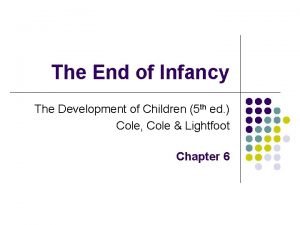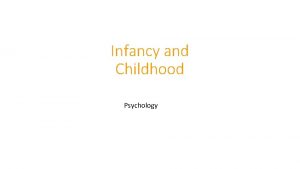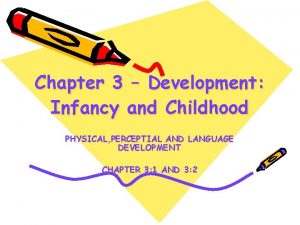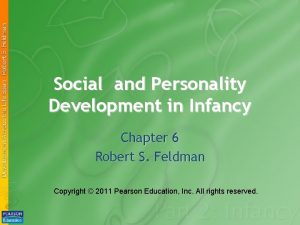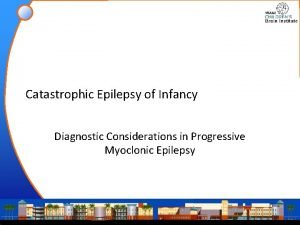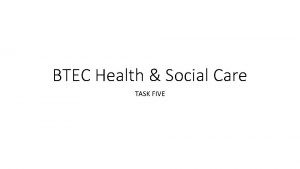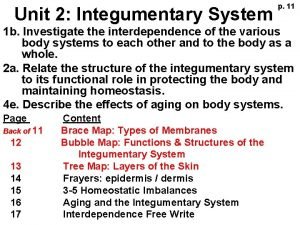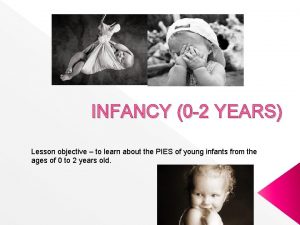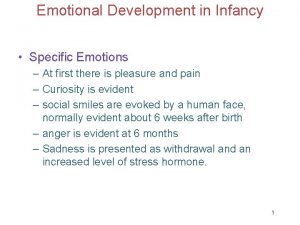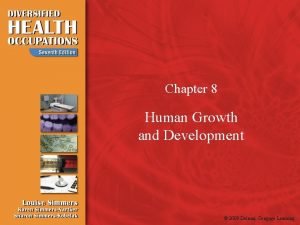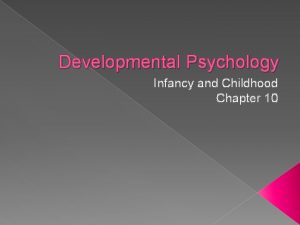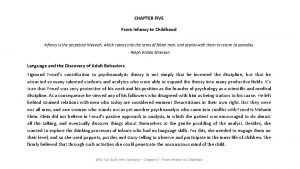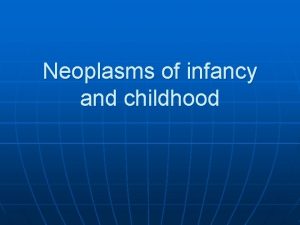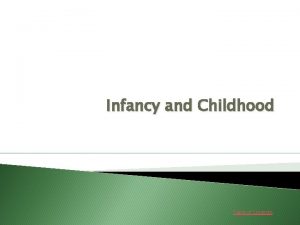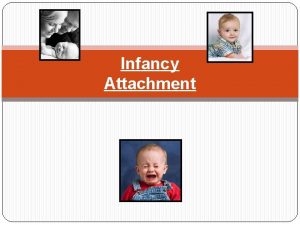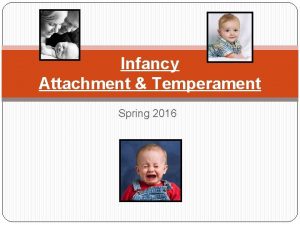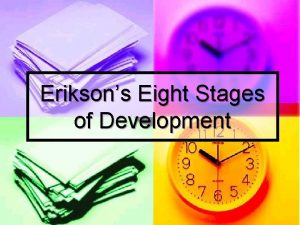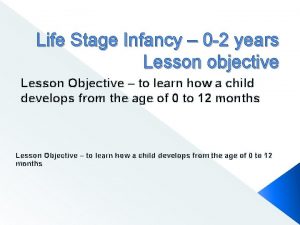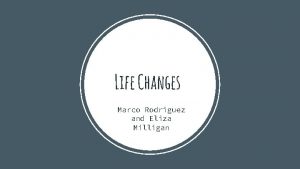LIFE STAGES Chapter 8 Overview of Stages Infancy






































- Slides: 38

LIFE STAGES Chapter 8

Overview of Stages Infancy Birth to 1 year Early Childhood 1 -6 years Late Childhood 6 -12 year Adolescence 12 -18 years Early Adulthood 19 -40 years Middle Adulthood 40 -65 years Late Adulthood 65 years and older

Infants and Toddlers • Infancy generally refers to the first year of life. • Toddler refers to the second year of life. • During this time, children continue to progress rapidly in all areas of development.

Infants and Toddlers: Physical Development • Infants: ▫ Establish a day and night sleeping pattern ▫ Hold up their heads, roll over, and reach for things ▫ Hearing and depth perception improve ▫ Crawl and then walk • Toddlers: ▫ Gain weight and height ▫ Run, jump, and climb ▫ Scribble and stack blocks

Infants and Toddlers: Mental Development • Infants: ▫ Imitate facial expressions Recognize people, places, and objects ▫ Make sounds that resemble spoken language ▫ • Toddlers: ▫ Experiment with objects Play make-believe ▫ Imitate adults ▫ Begin to speak and communicate ▫ Build a 200 -word vocabulary ▫

Infants and Toddlers: Emotional Development • Infants: ▫ Show basic emotions ▫ Anger and fear increase ▫ Develop stranger anxiety ▫ May develop separation anxiety • Toddlers: ▫ Show empathy ▫ Able to cooperate ▫ Begin to express shame, embarrassment, and pride ▫ Self-control emerges

Infants and Toddlers: Social Development • Infants: ▫ Begin to smile and laugh ▫ Match emotional facial expressions of adults ▫ Able to interpret others’ emotions • Toddlers: ▫ Play with siblings ▫ Show signs of gender- stereotypical toy choices

Infant Health Issues • Infants and toddlers should have a series of immunizations to prevent several diseases, such as hepatitis B and polio. • Children are also susceptible to accidental injuries, such as choking, drowning, and poisoning. • These fatal situations are often avoidable when children are given proper care and watched closely.

Early Childhood • Early childhood generally occurs between the ages of 1 and 6. • During this time, children continue to develop physically, intellectually, emotionally, and socially.

Early Childhood: Physical Development • Physical growth slows down. • Motor skills improve, allowing for greater coordination and balance. • A preference for the left or right hand develops. • They begin to lose primary teeth and grow adult teeth.

Early Childhood: Mental Development • They can see simple situations from someone else’s point of view. • A greater attention span develops. • The ability to count up and down develops along with the capability to perform simple addition and subtraction problems. • Language and memory skills improve.

Early Childhood: Emotional Development • They tend to shift quickly from confident to unsure. • The feeling of frustration erupts easily due to the increasing intellectual abilities that are developing faster than physical abilities. • They develop self-esteem and learn to express their emotions in acceptable ways.

Early Childhood: Social Development • Children in this stage generally become better communicators. • Most children understand sharing and begin to play with other children, which is called cooperative play.

Early Childhood Health Issues • Children at this age have a considerable drop in appetite as their growth slows down. • Because they are eating less, it is particularly important to make sure that all that they eat is good for them. • Children in this stage still need plenty of adult supervision and guidance about safety issues.

Middle Childhood • Middle childhood generally occurs between the ages of 6 and 11. • During this time, children continue to develop physically, intellectually, emotionally, and socially.

Middle Childhood: Physical Development • Children can write smaller and neater. • Their drawings become more detailed. • Motor skills become more developed, including the abilities to run, jump, kick, throw, and catch.

Middle Childhood: Mental Development • Children in this stage display great strides in intellectual growth. • Their ability to think logically and understand more complex ideas develops. • They can employ strategies to remember things.

Middle Childhood: Emotional Development • Children in this stage of development become more independent and responsible as their confidence grows. • They may be able to describe their own personalities and explain their emotions. • They also have more self- esteem than younger children.

Middle Childhood: Social Development • They understand that people’s perspectives on issues are caused by the information that they have. • They can view their relationships with others from a third-party’s point of view. • They develop friendships that are based on trust. • Their personalities and interests become more gender stereotypical.

Middle Childhood Health Issues • Nearsightedness • Ear infections • Obesity • Malnutrition • Bedwetting

Adolescence • Adolescence generally occurs between the ages of 11 and 20. • Most attention is paid to the first half of this stage of development. • Adolescence is a time of transitioning from childhood to adulthood in each area of development.

Adolescence: Physical Development • Females: ▫ Gain up to 40 pounds & grow up to 10 inches ▫ Begin to menstruate ▫ Develop secondary sexual characteristics (pubic hair, breasts, wider hips, more fat) • Males: ▫ Grow much taller and develop muscle mass ▫ Reproductive organs mature ▫ Develop secondary sexual characteristics (deeper voice, muscle mass, broader shoulders, pubic/facial hair)

Adolescence: Mental Development • Adolescents develop better critical thinking skills, which enable them to interpret and evaluate information. • They become idealistic about the world around them. However, they may also become more critical, when the world does not live up to their ideals.

Adolescence: Emotional Development • Adolescence is a challenging and confusing time for many young people. They seek to establish their identities. • They are self-conscious and often influenced by the thought that everyone is watching them. • They are often and easily embarrassed.

Adolescence: Social Development • Adolescents love to socialize with their friends. • They each develop their own sense of morals and values largely based on what their parents have taught them. • They also develop an awareness and interest in the opposite sex.

Adolescent Health Issues • Feelings of inadequacy are often displayed in the form of eating disorders, such as anorexia nervosa and bulimia. • Some adolescents turn to chemical substances for stress relief, because of peer pressure, or to escape from problems. • Suicide is a leading cause of death in adolescence.

Early Adulthood • Early adulthood generally occurs between the ages of 20 and 40. • During this time, adults continue to develop and change physically and intellectually. • They also continue to change socially and emotionally. However, at this point in life, these two areas become difficult to distinguish.

Early Adulthood: Physical Development • Early in this stage: ▫ In prime physical condition ▫ Typically stronger and faster • Later in this stage: ▫ Body need to be stretched and warmed up to prevent injury ▫ Metabolism slows down ▫ Decline in vision and hearing ▫ Hair begins to thin and gray ▫ Women may have fertility problems

Early Adulthood: Mental Development • People typically settle in a career and develop expertise in that field. • Creativity tends to increase. • Later in this stage, people are better able to manage many responsibilities at one time and to balance work and home life.

Early Adulthood: Emotional and Social Development • Adults develop an image of themselves in relation to the adult world around them. • Adults develop values, skills, and credentials in the workplace. • They acquire fulfilling adult friendships and work contacts. • They might get married and have children.

Middle Adulthood • Middle adulthood generally occurs between the ages of 40 and 60. • They continue to develop and change physically and intellectually. • They also continue to change socially and emotionally. As in early adulthood, at this point in life, these two areas are difficult to distinguish.

Middle Adulthood: Physical Development • People typically experience some high- frequency hearing loss, declining vision, and loss of lean body mass. • The hair continues to thin and gray and weight gain occurs. Skin begins to wrinkle and sag due to loss of elasticity. • Disks in the spinal column begin to collapse, which could result in shrinking as much as an inch in height. • In women, menopause occurs.

Middle Adulthood: Mental Development • Middle adults experience an increase in problem-solving abilities and expertise. • However, there are decreases in the ability to: Remember large quantities of information ▫ Retrieve information from memory ▫ Multi-task ▫

Middle Adulthood: Emotional and Social Development • Middle adults become concerned about the next generation and have a desire to guide and connect with it. • Self-acceptance is at its best. • Some people retire. • Family relationships change: ▫ Children become independent. ▫ Parents begin to age and need assistance. ▫ Sibling relationships become more satisfying.

Late Adulthood • Late adulthood generally occurs between the ages of 60 and 80. • During this time, adults continue to develop and change physically and intellectually. • They also continue to change socially and emotionally. However, at this point in life, these two areas become difficult to distinguish.

Late Adulthood: Physical Development • The body continues to decline: ▫ Vision and hearing decline. ▫ Senses of taste, smell, and touch become less sharp. ▫ The immune system ages. ▫ Bone mass continues to diminish. • Neurons die at a faster rate. However, the brain compensates with new synapses.

Late Adulthood: Mental Development • Late adults continue to experience a decline in their ability to recall from their memories. • Finding the right words and organizing them into speech become increasingly challenging • Although late adulthood includes the continued decline of some functions, people in this stage of life are at their most wise.

Late Adulthood: Emotional and Social Development • People at this stage may be widowed. If they are not widowed, they are probably more satisfied with their marriages than in the past. • Their relationships with siblings become even stronger. • They may become grandparents or great- grandparents. • Their faith and spirituality may become more important. • They also have an increased interest in politics and are more likely to vote.
 Late childhood
Late childhood Chapter 10 infancy and childhood
Chapter 10 infancy and childhood Chapter 10 infancy and childhood review worksheet answers
Chapter 10 infancy and childhood review worksheet answers Chapter 10 infancy and childhood review worksheet answers
Chapter 10 infancy and childhood review worksheet answers Chapter 5 cognitive development in infancy and toddlerhood
Chapter 5 cognitive development in infancy and toddlerhood Social development in infancy
Social development in infancy Infancy period
Infancy period Socioemotional development in infancy
Socioemotional development in infancy Infancy psychosocial development
Infancy psychosocial development Module 47 infancy and childhood cognitive development
Module 47 infancy and childhood cognitive development Infancy and childhood psychology
Infancy and childhood psychology Various stages of growth are
Various stages of growth are Principles of growth and development
Principles of growth and development Infancy and childhood physical development
Infancy and childhood physical development Infancy
Infancy Personality development in infancy
Personality development in infancy Infancy physical changes
Infancy physical changes Personality development in infants
Personality development in infants Catastrophic epilepsy infancy
Catastrophic epilepsy infancy What is intellectual in health and social care
What is intellectual in health and social care Lesson quiz 3-2 infancy and childhood
Lesson quiz 3-2 infancy and childhood The cases of anna, isabelle and genie
The cases of anna, isabelle and genie Infancy childhood adolescence adulthood old age
Infancy childhood adolescence adulthood old age Pies in infancy
Pies in infancy Pavlik harness
Pavlik harness New emotions that appear toward the second year
New emotions that appear toward the second year Infancy
Infancy Rovee-collier
Rovee-collier Messianic prophecies fulfilled in the infancy narratives
Messianic prophecies fulfilled in the infancy narratives Module 47 infancy and childhood cognitive development
Module 47 infancy and childhood cognitive development Chapter 8:1 life stages
Chapter 8:1 life stages Chapter 24 trauma overview
Chapter 24 trauma overview Chapter 14 medical overview
Chapter 14 medical overview Chapter 9 lesson 2 photosynthesis an overview
Chapter 9 lesson 2 photosynthesis an overview Chapter 12 selling overview
Chapter 12 selling overview Chapter 2 an overview of the financial system
Chapter 2 an overview of the financial system Chapter 1 overview of verb tenses
Chapter 1 overview of verb tenses Overview of personal finance chapter 1
Overview of personal finance chapter 1 Distoclusion definition
Distoclusion definition






